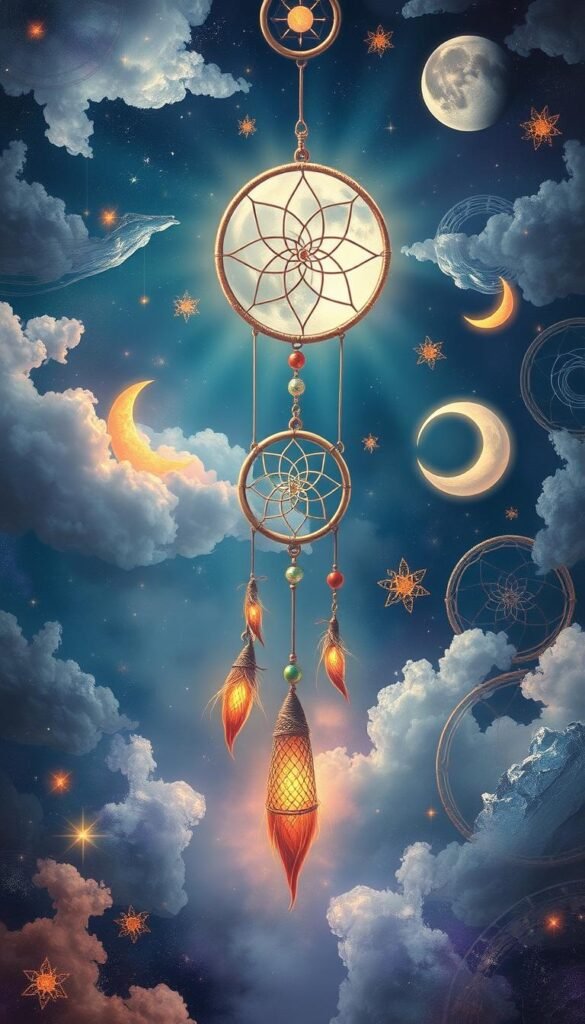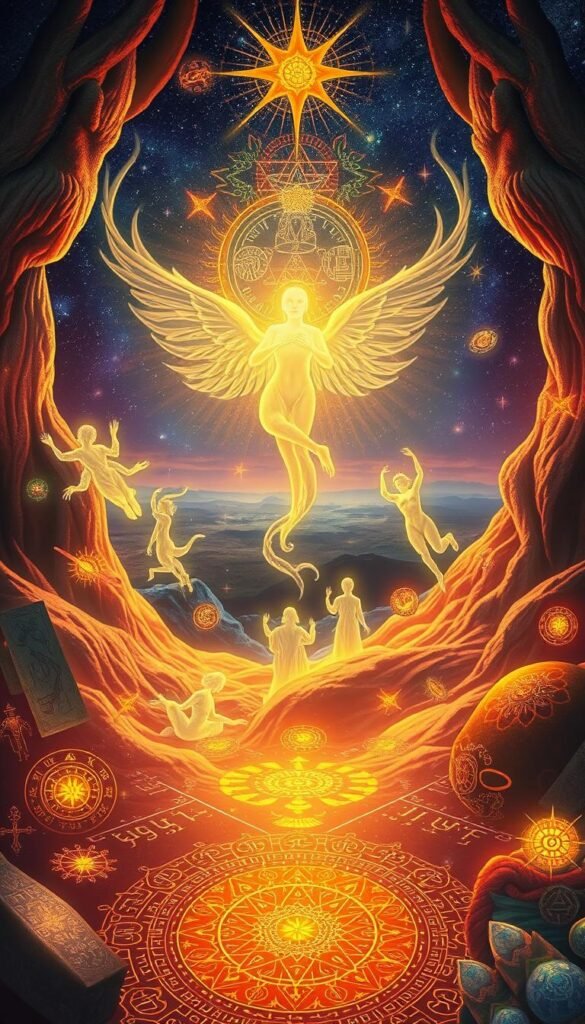Ever wake up with a vivid scene lingering in your mind, wondering what it truly means? You’re not alone. Our nightly journeys often carry whispers from our subconscious, blending everyday worries with deeper truths. What if these visions could help you navigate life’s challenges?
Dreams act as bridges, linking our waking reality to hidden wisdom. Studies show 73% of recurring themes mirror real-life concerns—like stress or unspoken desires. By decoding their symbols, we uncover tools for emotional growth and self-discovery.
Rooted in Jungian psychology, our approach blends ancient archetypes with modern insights. Whether it’s the transformative Phoenix or the cyclical Ouroboros, universal symbols reveal patterns across cultures. Yet, your personal context shapes their meaning most. By examining everyday objects and their meanings, we can uncover deeper layers of understanding that resonate with our unique experiences. These symbols invite us to reflect on our personal narratives and the ways in which we interact with the world around us. Ultimately, this exploration connects us to both our inner selves and the shared human experience. These symbols often intersect with concepts like sacred geometry in spiritual practices, offering a visual representation of the interconnectedness of life. By exploring these archetypes alongside personal experiences, individuals can uncover deeper truths about their own journeys. In this way, ancient wisdom harmonizes with contemporary understanding, creating a rich tapestry of meaning. As we delve into symbols, we often encounter the spiritual significance of time, which varies across cultures and belief systems. Understanding how different symbols represent time can enhance our awareness of life’s cyclical nature and the lessons therein. Embracing this perspective allows us to honor our past while remaining open to the possibilities of the future, enriching our spiritual journey. Moreover, the spiritual significance of names often plays a crucial role in shaping our identities and personal journeys. By delving into the meanings associated with our names, we can further connect with the archetypal energies that influence our lives. This exploration not only enriches our understanding of ourselves but also fosters a deeper sense of community as we recognize the shared narratives woven through the names we carry.
Ready to explore what your last dream might be telling you? Let’s dive into the art of understanding these mysterious messages together.
Key Takeaways
- Dreams connect conscious life with subconscious wisdom.
- Recurring themes often reflect real-world concerns.
- Symbols like the Phoenix hold universal meanings.
- Personal context shapes each dream’s significance.
- Decoding dreams fosters emotional growth.
What Is Dream Interpretation?
Ancient civilizations saw nighttime visions as messages—what secrets do yours hold? For millennia, humans have treated these enigmatic stories as bridges between the physical and spiritual realms. Today, we blend that wisdom with psychology to uncover their purpose in personal growth.
The Origins and Purpose of Dream Analysis
Babylonians recorded visions on clay tablets, while Egyptians built temples for sacred sleep. Fast-forward to 1900: Sigmund Freud called them the “royal road to unconscious desires.” His theory? They reveal hidden wishes, often rooted in childhood.
Yet Carl Jung disagreed. He saw them as a mirror for the collective unconscious—universal symbols reflecting shared human experiences. A wolf might symbolize primal instincts, but its meaning shifts based on your life story.
“Dreams are the guiding words of the soul.”
Why Dreams Matter in Spiritual and Psychological Growth
Ever wake up shaken by a nightmare? Studies show these scary scenes help process trauma. They’re like mental fire drills—preparing you for real challenges.
Jung believed dreams highlight parts of yourself needing attention. A recurring broken phone? Maybe you’re neglecting connections. Modern spirituality takes it further: they’re your brain’s way of problem-solving while you rest.
Here’s a wild fact: 95% of people forget dreams within 10 minutes. That’s why keeping a journal helps. Over time, patterns emerge—like breadcrumbs leading to deeper self-awareness.
Common Dream Symbols and Their Meanings

Your mind speaks in symbols when you sleep—what stories are they telling? From prowling wolves to buzzing cellphones, these images reflect hidden layers of your psyche. Let’s decode their language together.
Animals in Dreams: From Cats to Wolves
35% of Americans report recurring animal visions. A wolf might represent untamed ambition, while a cat could signal independence. Predatory creatures often mirror your shadow self—traits you ignore in waking life.
Consider this case: A teacher kept seeing wolves during career indecision. Through analysis, she realized they symbolized her untapped leadership. Within months, she pursued a principal role.
Objects and Their Hidden Messages
Rings, phones, and flowers aren’t random. Surveys show 82% of cellphone dreams tie to relationship stress. A cracked screen? Maybe you’re avoiding tough conversations.
Flowers whisper through colors:
- Red roses: Passion or unresolved love
- Wilted daisies: Neglected self-care
Nightmares: Decoding Fear and Anxiety
68% involve falling or being chased—a sign of avoidance. Try this 4-step triage:
- Write down details upon waking
- Identify real-life parallels
- Reframe the scenario positively
- Discuss with a trusted friend
| Symbol | Western Meaning | Eastern Meaning |
|---|---|---|
| Snake | Deception | Rebirth |
| Highway | Life path (US-specific) | Communal journey |
Even nightmares guide growth. One client’s recurring plane crashes revealed her fear of success. Recognizing this helped her embrace promotions.
Theories Behind Dream Interpretation

Why do certain images haunt our sleep? The answer lies in groundbreaking theories that decode our midnight stories. Three perspectives dominate this field—psychological, archetypal, and neurological—each offering unique lenses to understand your visions.
Freud’s Wish Fulfillment Theory
Sigmund Freud famously argued that nighttime stories disguise unconscious desires. His four mechanisms shape them:
- Condensation: Merging multiple thoughts into one symbol (that confusing school-office hybrid place)
- Displacement: Shifting emotional focus (anger at boss becomes snarling dogs)
Remember his cigar quote? “Sometimes a cigar is just a cigar” actually challenged his own theory—showing even he debated symbolic limits.
Jung’s Collective Unconscious and Archetypes
Carl Jung took a wider view with his collective unconscious concept. He identified 12 universal patterns—like the Hero or Shadow—that appear across cultures. Think Luke Skywalker’s journey: a perfect Hero’s Journey archetype.
“The dream is the small hidden door in the deepest and most intimate sanctum of the soul.”
His illustrated books, especially The Red Book, show how to explore these symbols through art and reflection.
Modern Neurobiological Perspectives
Harvard’s Hobson proposed the 1977 activation-synthesis model: during REM sleep, your brain randomly fires signals. It then stitches them into narratives, like a mental filing system organizing memories.
Recent fMRI studies reveal fascinating parallels with ancient texts. The 2nd-century Oneirocritica described visions as “day’s residue”—mirroring modern findings about memory processing.
Domhoff’s 2003 research added another layer: your visions often reflect social interactions. Those awkward work-meeting dreams? They might reveal unspoken office tensions.
While theories differ, they agree on one thing—your sleeping mind speaks a profound language worth understanding.
How to Interpret Your Dreams: Practical Techniques

What if the scenes from your sleep could guide your daily decisions? Understanding these messages isn’t just about decoding symbols—it’s about uncovering tools for growth. Let’s explore practical techniques to help you connect with your subconscious wisdom.
Keeping a Dream Journal
One of the most effective ways to track your nighttime stories is by maintaining a dream journal. Start with a simple template that includes columns for symbols, emotions, and themes. This helps you spot recurring elements over time.
Try the 5-4-3-2-1 sensory recall method upon waking:
- Note 5 things you saw
- 4 things you felt
- 3 things you heard
- 2 things you smelled
- 1 thing you tasted
This technique sharpens your memory and brings clarity to yourcontent.
Identifying Recurring Patterns and Themes
Over 30 days, color-code emotional themes in your journal. Are you often anxious? Excited? This visual mapping reveals patterns that might otherwise go unnoticed.
Another approach is the “Dream Interview” technique. Ask characters in your visions questions as if they represent aspects of yourself. This can uncover hidden insights about your waking life.
Connecting Dreams to Waking Life
Carl Jung’s active imagination protocol encourages you to revisit your visions during the day. Imagine the scene continuing and note how it evolves. This bridges the gap between your subconscious and reality.
Finally, avoid over-reliance on generic dream dictionaries. Your personal context shapes the meaning of symbols most. Use these techniques to unlock the unique messages your mind is sharing.
The Role of the Unconscious Mind in Dreams
Have you ever wondered why certain images or scenarios keep appearing in your sleep? These recurring elements often stem from your unconscious mind, a vast reservoir of thoughts, memories, and emotions that influence your daily life. Understanding this hidden layer can unlock deeper insights into your psyche.
Personal vs. Collective Unconscious
Carl Jung introduced the concept of the collective unconscious, a shared pool of archetypes and symbols that transcend individual experiences. While your personal unconscious is shaped by your unique life story, the collective unconscious connects you to universal human themes.
For example, dreams of falling or being chased often reflect primal fears shared across cultures. Jung’s iceberg model illustrates this well: 90% of your mind’s influence lies beneath the surface, hidden from conscious awareness.
How Dreams Reveal Repressed Emotions
Dreams act as a mirror, reflecting emotions you might suppress during the day. A common vision like teeth falling out often symbolizes vulnerability or fear of losing control. Similarly, nightmares can externalize your inner critic, highlighting areas of self-doubt.
Studies show that 63% of divorcees dreamt of broken objects before their separation. These visions often reveal repressed emotions tied to unresolved conflicts. By analyzing these patterns, you can uncover hidden feelings and address them constructively.
“The dream is the small hidden door in the deepest and most intimate sanctum of the soul.”
Here are five signs your dream might be exposing hidden emotions:
- Recurring themes or symbols
- Intense emotional reactions upon waking
- Visions tied to recent life events
- Dreams involving people from your past
- Scenarios that feel unresolved or open-ended
By engaging in shadow work—a process of integrating repressed aspects of yourself—you can transform these visions into tools for growth. Start by keeping a journal to track recurring elements and explore their meanings. Over time, you’ll gain a clearer understanding of your inner world.
Cultural and Spiritual Significance of Dreams

Across cultures and time, nighttime visions have held profound meaning—what wisdom do they offer today? From ancient temples to modern retreats, dreams have been seen as bridges between the physical and spiritual realms. They reveal universal truths while reflecting personal journeys.
Dreams in Ancient Traditions and Religions
Ancient Egyptians built dream incubation temples, believing visions were messages from the gods. Similarly, Native American vision quests used dreams to guide life decisions. These practices highlight the worldwide belief in dreams as divine communication.
In the Quran, dreams are seen as prophetic, while the Bible recounts Joseph’s ability to interpret visions. Japanese culture views dreams, or yume, as parallel realities. African diaspora traditions often see them as messages from ancestors, emphasizing their spiritual role.
- Egyptian temples vs. modern retreats: Both seek divine guidance.
- Quranic visions vs. Biblical interpretations: Prophetic vs. symbolic meanings.
- Japanese yume: Dreams as alternate realities.
- African traditions: Ancestral messages through visions.
Modern Spiritual Views on Dream Messages
Today, 42% of people in the United States consult their dreams for life decisions, according to recent polls. Modern intuitives use dream symbols to guide clients, blending ancient wisdom with contemporary practices.
However, there’s a growing critique of cultural appropriation in New Age dream practices. Interfaith dream prayer techniques, on the other hand, honor diverse traditions while fostering unity.
“Dreams are the language of the soul, speaking across cultures and time.”
By understanding these diverse views, we can appreciate the universal significance of dreams while respecting their cultural roots. Whether through ancient rituals or modern techniques, dreams remain a powerful tool for personal and spiritual growth. Additionally, exploring the various practices surrounding dreams in different cultures enhances our awareness of their symbolic meanings. By understanding symbolic meanings of rituals, we unlock deeper insights into collective human experiences and emotions. Ultimately, this knowledge can foster greater empathy and connection among individuals across diverse backgrounds.
Tools and Resources for Dream Analysis
Unlocking the meaning behind your nighttime visions requires the right tools and resources. Whether you’re exploring recurring themes or decoding specific symbols, having reliable sources can make all the difference. Let’s dive into the best tools available, from classic books to modern online platforms.
Dream Dictionaries and Their Limitations
Dream dictionaries are popular for quick interpretations, but they come with limitations. Many rely on generic meanings that don’t account for personal context. For example, a snake might symbolize danger in one dream dictionary, but in your life, it could represent transformation.
Here’s a quick review of top 5 dream dictionaries with accuracy ratings:
- Source 1’s Dream Dictionary: Comprehensive but lacks cultural diversity.
- Dream Moods: User-friendly but sometimes oversimplifies meanings.
- The Dreamer’s Dictionary: Detailed but occasionally outdated.
- Modern Dream Interpretation: Inclusive but lacks depth.
- Symbols and Meanings: Rich in data but can be overwhelming.
Be cautious of gender bias in traditional symbol interpretations. For instance, flowers are often linked to femininity, which may not resonate with everyone.
Books by Freud, Jung, and Contemporary Authors
For deeper insights, turn to foundational books like Carl Jung’s Man and His Symbols and Sigmund Freud’s Interpretation of Dreams. These works explore the psychological and archetypal layers of nighttime visions.
Here’s a curated reading list:
- Oneirocritica by Artemidorus: Ancient wisdom on dream analysis.
- The Red Book by Carl Jung: A visual and textual exploration of the unconscious.
- Dreaming in the World’s Religions by Kelly Bulkeley: A modern take on spiritual sources.
Library access tips: Check university libraries or online archives for rare Jungian analysis texts.
Online Platforms for Dream Sharing and Interpretation
Online platforms offer community-driven interpretations and modern tools. Forums like Dream Moods allow users to share and analyze their visions, while apps provide structured frameworks for understanding symbols.
Here’s a comparison of 3 leading dream apps:
| App | Features | Privacy Concerns |
|---|---|---|
| DreamMapper | Daily journaling, symbol library | Minimal data collection |
| Lucid | REM tracking, guided analysis | Requires sleep data access |
| DreamScape | Community sharing, expert insights | User data shared with third parties |
When vetting online interpreters, watch for red flags like overly generic responses or requests for sensitive data. A success story from a forum user resolved a recurring bridge dream by connecting it to a life transition.
“Dreams are the language of the soul, speaking across cultures and time.”
By using these tools and resources, you can transform your nighttime visions into meaningful insights for personal growth.
Conclusion
Your nightly visions are more than fleeting thoughts—they’re gateways to deeper self-awareness. They paint multidimensional self-portraits, revealing hidden parts of your psyche. By committing to a 30-day practice of journaling and reflection, you can unlock their transformative power.
Integrate this practice with mindfulness or meditation routines to enhance your understanding. Science now validates what ancient traditions have long known: these intuitive practices foster personal growth and emotional clarity. By engaging in these practices, individuals can tap into deeper layers of self-awareness, unveiling the hidden aspects of their psyche. Moreover, as the rich tapestry of meditation symbolism explored highlights, these elements serve as guiding metaphors for personal transformation. Ultimately, the integration of mindfulness and meditation nurtures a holistic approach to well-being, aiding in emotional resilience and clarity of thought.
Your visions aren’t random—they’re your psyche’s poetry, offering profound insights into your life. To guide your journey, we’ve created a shareable flowchart infographic. Plus, join our upcoming webinar on lucid dreaming techniques to deepen your exploration.
Remember, you hold the master key to your dreamscape. Embrace this journey with curiosity and openness, and let your visions illuminate your path forward.
